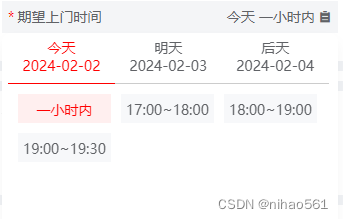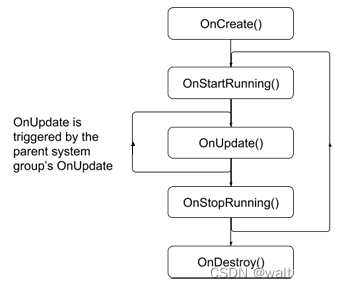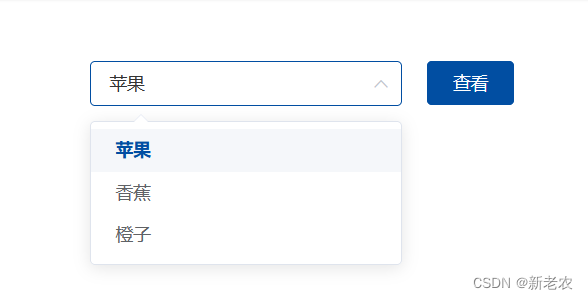一直对开源UI组件库比较感兴趣,摸索着开发了一套,虽然还只是开始,但是从搭建到发布这套流程基本弄明白了,现在分享给大家,希望对同样感兴趣的同学有所帮助。
目前我的这套名为hasaki–ui的组件库仅有两个组件,大致成果如下,后续有时间会继续完善。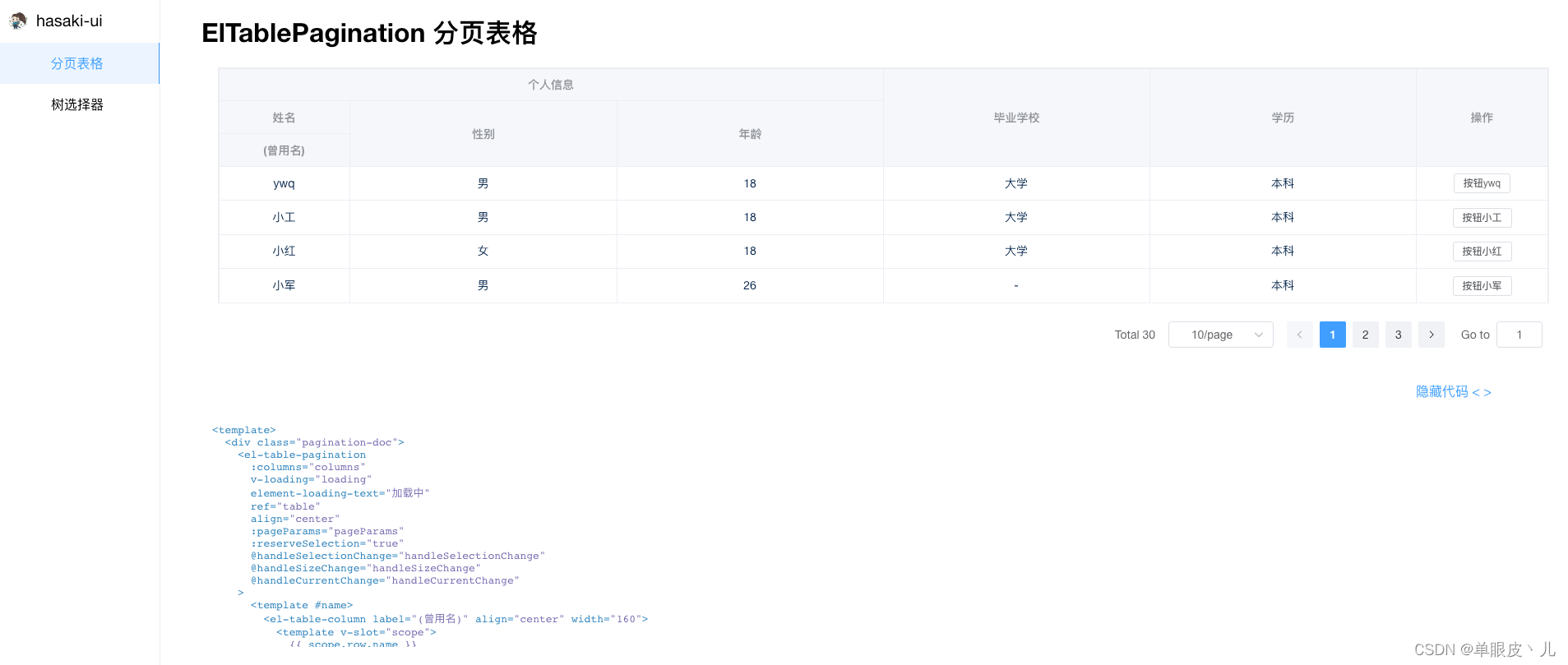
该项目采用的技术栈为Vite + Vue3,还使用了一些基本的Markdown知识,阅读本文档前,希望你至少对vue有些基础,那么我们正式开始。
一、创建一个Vite项目
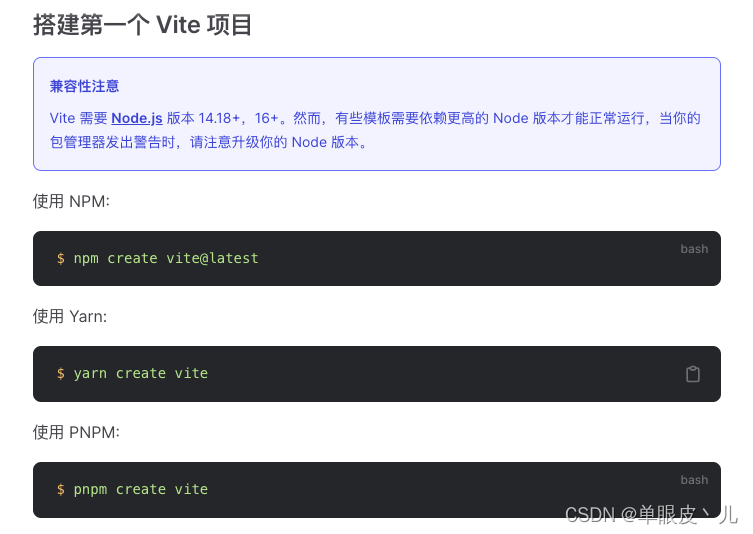 参照vite官网,打开命令行,执行上述命令之一,按提示操作即可,创建完成后,你得到了一个以你创建的项目名为名的一个文件夹,我的为hasaki–ui,直接以成品进行说明吧。
参照vite官网,打开命令行,执行上述命令之一,按提示操作即可,创建完成后,你得到了一个以你创建的项目名为名的一个文件夹,我的为hasaki–ui,直接以成品进行说明吧。
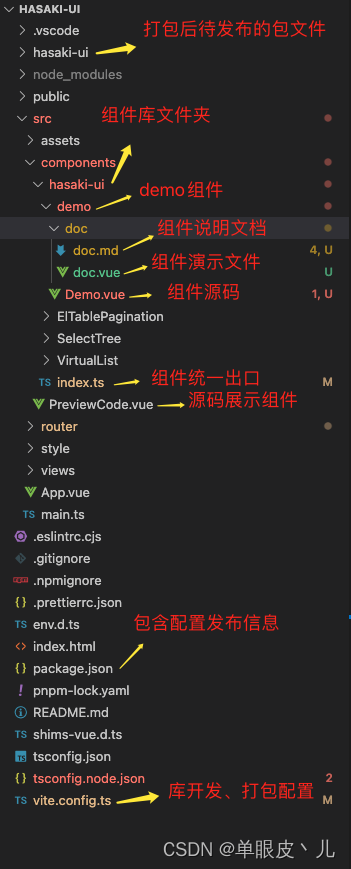
二、组件开发
本文重点不在于某个组件的开发,而是库开发的配置、发布流程,所以在此以一个很简单的demo组件作为说明。

doc.md为组件的说明文档,一般是用 Markdown 来写。这里我们需要使用 vite–plugin–vue–markdown插件来将 md 文件转换成 vue 文件。
// doc.md
<script setup>
import doc from './doc.vue';
import PreviewCode from '@/components/PreviewCode.vue'
</script>
# DEMO
<doc/>
<PreviewCode compName="demo" />
// doc.vue
<template>
<div class="demo-doc">
<Demo />
</div>
</template>
<script lang="ts">
export default {
name: 'DemoDoc'
}
</script>
<script lang="ts" setup></script>
<style lang="scss" scoped>
.demo-doc {
width: 100%;
height: 100%;
padding: 20px;
}
</style>
库组件
// Demo.vue
<template>
<div class="demo">
Demo is here
</div>
</template>
<script lang="ts">
export default {
name: 'Demo'
}
</script>
<script lang="ts" setup>
import { onMounted } from 'vue'
onMounted(() => {
console.log('demo 出现啦')
})
// endregion
</script>
<style lang="scss" scoped>
.demo {
height: 100%;
width: 100%;
display: flex;
flex-direction: column;
overflow: hidden;
}
</style>
PreviewCode.vue组件用于获取组件源码,用于在页面展示源码
// PreviewCode.vue
<template>
<div class="preview-code">
<div class="showCode" @click="showOrhideCode">
<span>{{ showCode ? '隐藏代码' : '显示代码' }} &lt; &gt;</span>
</div>
<el-scrollbar>
<transition>
<pre v-highlight v-if="showCode">
<code>{{ sourceCode }}</code>
</pre>
</transition>
</el-scrollbar>
</div>
</template>
<script setup>
import { onMounted, ref } from 'vue'
const props = defineProps({
compName: {
type: String,
default: '',
require: true
}
})
const showCode = ref(false)
const sourceCode = ref('')
const showOrhideCode = () => {
showCode.value = !showCode.value
}
const getSourceCode = async () => {
let code = await import(
/* @vite-ignore */ `@/components/hasaki-ui/${props.compName}/doc/doc.vue?raw`
)
sourceCode.value = code.default
}
onMounted(() => {
getSourceCode()
})
</script>
<style lang="scss">
.preview-code {
height: 300px;
.showCode {
cursor: pointer;
color: #777;
text-align: right;
padding-right: 50px;
&:hover {
color: #409eff;
}
}
}
.v-enter-active,
.v-leave-active {
transition: all 0.5s ease;
}
.v-enter-from,
.v-leave-to {
opacity: 0;
transform: translateY(200px);
}
</style>
组件出口
// index.ts
import ElTablePagination from './ElTablePagination/ElTablePagination.vue'
import SelectTree from './SelectTree/SelectTree.vue'
import Demo from './demo/Demo.vue'
// 按需引入
export { ElTablePagination, SelectTree, Demo }
const component = [ElTablePagination, SelectTree, Demo]
const HasakiUI = {
install(App: any) {
component.forEach((item) => {
App.component(item.name, item)
})
}
}
export default HasakiUI
import { createApp } from 'vue'
import App from './App.vue'
import router from './router'
import HasakiUI from './components/hasaki-ui'
import hljs from 'highlight.js' // 引入代码高亮文件
import 'highlight.js/styles/color-brewer.css'
const app = createApp(App)
app.directive('highlight', function (el) {
const blocks = el.querySelectorAll('pre code')
blocks.forEach((block) => {
hljs.highlightBlock(block)
})
})
app.use(router)
app.use(HasakiUI)
app.mount('#app')
// views/home-page.vue
<template>
<div class="home-page">
<div class="home-page-sidebar">
<div class="logo">
<img src="/favicon.ico" alt="" />
hasaki-ui
</div>
<ul v-for="item in routes" :key="item">
<li
v-for="(ele, index) in item.children"
:key="ele"
:class="{ active: mIndex == index }"
@click="goPath(ele, index)"
>
{{ ele.name }}
</li>
</ul>
</div>
<main class="home-page-main">
<router-view></router-view>
</main>
</div>
</template>
<script setup>
import { computed, ref } from 'vue'
import { useRouter } from 'vue-router'
const router = useRouter()
const mIndex = ref(sessionStorage.getItem('mIndex') || '0')
const routes = computed(() => router.options.routes)
const goPath = (ele, index) => {
mIndex.value = index
router.push({
path: ele.path
})
sessionStorage.setItem('mIndex', index)
}
</script>
<style lang="scss" scoped>
.home-page {
display: flex;
justify-content: space-between;
width: 100%;
height: 100%;
overflow: hidden;
&-sidebar {
width: 200px;
height: 100%;
border-right: 1px solid #eee;
text-align: center;
.logo {
display: flex;
align-items: center;
padding: 15px;
font-size: 20px;
img {
width: 25px;
margin-right: 10px;
}
}
ul {
li {
height: 50px;
line-height: 50px;
cursor: pointer;
}
.active {
color: #409eff;
background-color: #ecf5ff;
border-right: 1px solid #409eff;
}
}
}
&-main {
flex: 1;
padding: 20px 50px;
overflow-y: auto;
}
}
</style>
// router/index.ts
import { createRouter, createWebHistory } from 'vue-router'
const routes = [
{
path: '/',
name: '组件页面',
component: () => import('@/views/home-page.vue'),
redirect: '/demo',
children: [
{
path: '/demo',
name: 'Demo',
// @ts-ignore
component: () => import('@/components/hasaki-ui/demo/doc/doc.md')
},
{
path: '/el-table-pagination',
name: '分页表格',
// @ts-ignore
component: () => import('@/components/hasaki-ui/ElTablePagination/doc/doc.md')
},
{
path: '/select-tree',
name: '树选择器',
// @ts-ignore
component: () => import('@/components/hasaki-ui/SelectTree/doc/doc.md')
}
]
}
]
const router = createRouter({
history: createWebHistory(import.meta.env.BASE_URL),
routes
})
export default router
// App.vue
<script setup lang="ts"></script>
<template>
<div class="main">
<RouterView />
</div>
</template>
<style scoped lang="scss">
.main {
width: 100vw;
height: 100vh;
}
</style>
Markdown 插件需要我们在vite.config.ts中进行配置
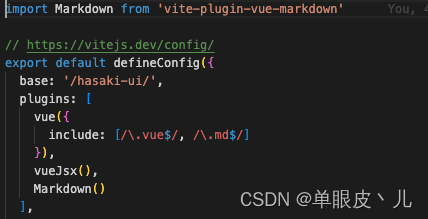

三、库模式开发打包配置
在此我们介绍如何把我们开发的组件库进行打包,重点是配置lib字段来进行库开发
// vite.config.ts
import { fileURLToPath, URL } from 'node:url'
import { defineConfig } from 'vite'
import vue from '@vitejs/plugin-vue'
import vueJsx from '@vitejs/plugin-vue-jsx'
import Markdown from 'vite-plugin-vue-markdown'
// https://vitejs.dev/config/
export default defineConfig({
base: '/hasaki-ui/',
plugins: [
vue({
include: [/.vue$/, /.md$/]
}),
vueJsx(),
Markdown()
],
build: {
outDir: 'hasaki-ui', //输出文件名称
lib: {
entry: fileURLToPath(new URL('./src/components/hasaki-ui/index.ts', import.meta.url)), //指定组件编译入口文件
name: 'hasaki-ui', // 包名
fileName: 'hasaki-ui' // 打包文件名
}, //库编译模式配置
rollupOptions: {
// 确保外部化处理那些你不想打包进库的依赖
external: ['vue', 'vue-router'],
output: {
// 在 UMD 构建模式下为这些外部化的依赖提供一个全局变量
globals: {
vue: 'Vue'
}
}
}, // rollup打包配置
terserOptions: {
// 在打包代码时移除 console、debugger 和 注释
compress: {
/* (default: false) -- Pass true to discard calls to console.* functions.
If you wish to drop a specific function call such as console.info and/or
retain side effects from function arguments after dropping the function
call then use pure_funcs instead
*/
drop_console: true, // 生产环境时移除console
drop_debugger: true // 生产环境时移除debugger
},
format: {
comments: false // 删除注释comments
}
}
},
resolve: {
alias: {
'@': fileURLToPath(new URL('./src', import.meta.url))
}
}
})
{
"name": "hasaki-ui", // 发布包的名称
"version": "0.0.5", // 版本号,每次更新注意升级版本号
"private": false, // 是否为私有,这里注意应为false
"main": "./hasaki-ui/hasaki-ui.umd.js", // 入口文件
"module": "./hasaki-ui/hasaki-ui.mjs", // 模块入口
"sideEffects": false,
"keywords": [
"hasaki",
"hasaki-ui",
"HasakiUI"
], // 搜索关键词
"description": "一款基于Element-Plus开发的UI组件库,适用于vue3,大多为PC端后台管理系统常用组件", // 描述
"author": "YXX", // 作者
"exports": {
"./hasaki-ui/style.css": "./hasaki-ui/style.css",
".": {
"import": "./hasaki-ui/hasaki-ui.mjs",
"require": "./hasaki-ui/hasaki-ui.umd.js"
}
}, // 引用路径映射,解决加载样式失败问题
"files": [
"hasaki-ui/*"
], // 描述了将软件包作为依赖项安装时要包括的条目,默认值为[“*”],这意味着它将包括所有文件,我们指定我们自己组件文件夹即可
// ..重要的就上面这些
}
执行 npm/yarn/pnpm run build进行打包,出现如下表示打包成功了
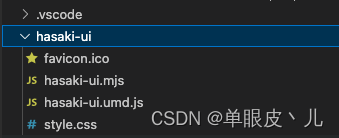
四、发布
这一步其实很简单,一个命令搞定,npm publish,但是初次发布需要登录你的npm:
1、执行npm login 命令,输入用户名和密码,输入密码时是看不到的,之后按提示输入绑定的邮箱,成功后你的邮箱会收到一个one-time password,填入后即登录成功。
3、发布前要注意查看你的npm源是否为官方源https://registry.npmjs.org ,如果不是要切回官方源,否则发布失败
4、发布成功后,到npm上就可以看到我们的包了,至此我们就有了自己的一个开源包。
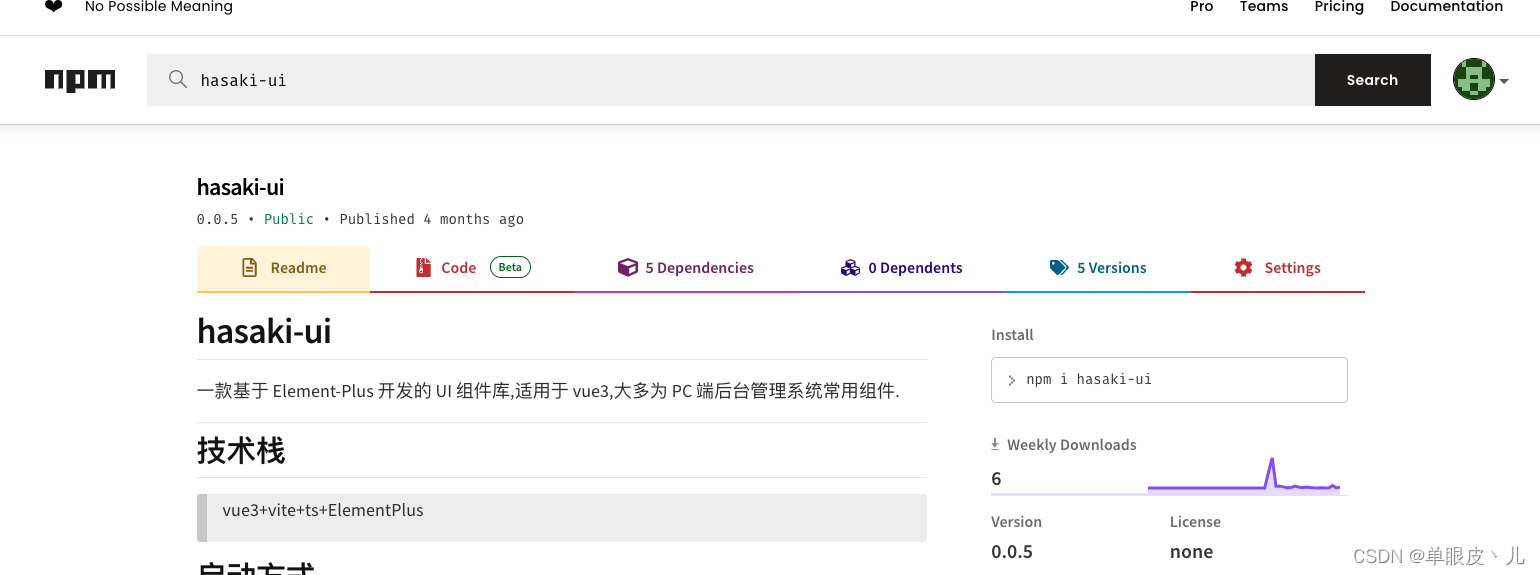
原文地址:https://blog.csdn.net/Y_wq0616/article/details/132022281
本文来自互联网用户投稿,该文观点仅代表作者本人,不代表本站立场。本站仅提供信息存储空间服务,不拥有所有权,不承担相关法律责任。
如若转载,请注明出处:http://www.7code.cn/show_31824.html
如若内容造成侵权/违法违规/事实不符,请联系代码007邮箱:suwngjj01@126.com进行投诉反馈,一经查实,立即删除!

